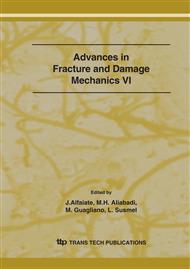p.665
p.669
p.673
p.677
p.681
p.685
p.689
p.693
p.697
Micro- and Macro-Approach to the Fatigue Crack Propagation in High-Strength Pearlitic Steel Wires
Abstract:
This paper analyzes how the cold drawing process influences the fatigue behaviour of eutectoid steel, with special emphasis on the role of microstructural changes induced during such a manufacturing process. Fatigue cracks are transcollonial and exhibit a preference for fracturing pearlitic lamellae, with non-uniform crack opening displacement values, micro-discontinuities, branchings, bifurcations and frequent local deflections that create microstructural roughness. The net fatigue surface increases with cold drawing due to the higher angle of crack deflections.
Info:
Periodical:
Pages:
681-684
Citation:
Online since:
September 2007
Authors:
Price:
Сopyright:
© 2007 Trans Tech Publications Ltd. All Rights Reserved
Share:
Citation:


